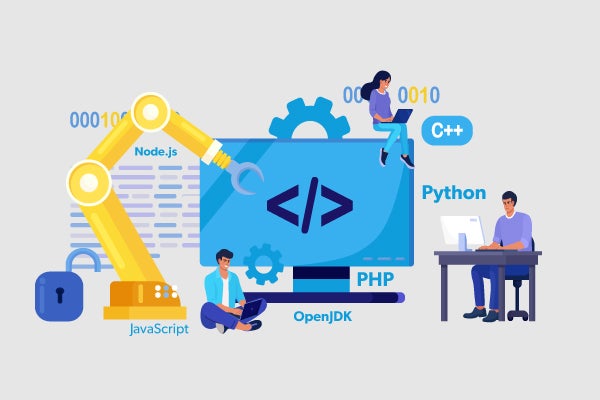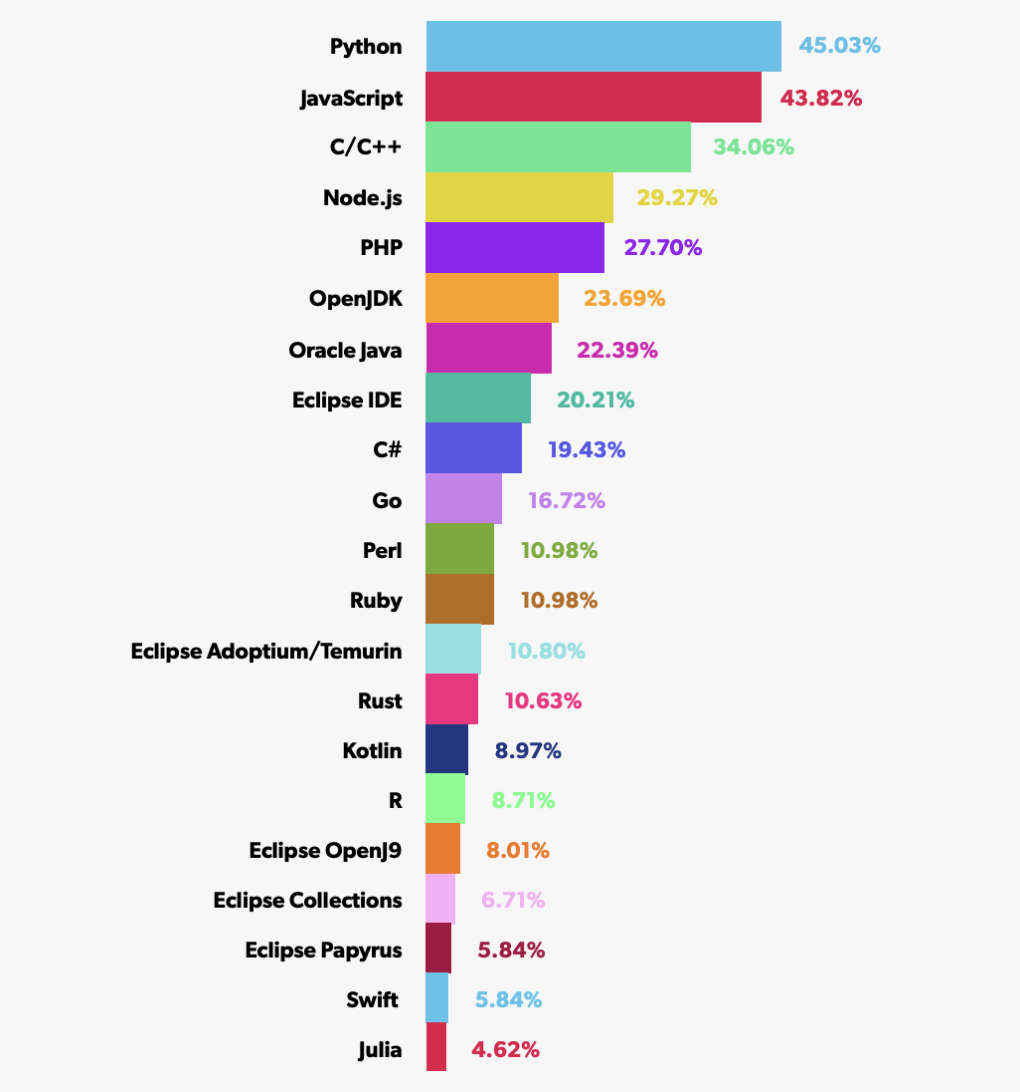
Open Source Programming Languages and Runtimes: Trends from the State of Open Source Report
All web development starts with the choice of programming language or runtime, which is why we always dedicate a section to them in the State of Open Source Report. We also know that using more than one runtime to build applications is not uncommon, so we allow survey respondents to select multiple technologies on this question.
Keep reading to find out how the results shook out in this category!
Back to top
Python Surpasses JavaScript As Most Used Programming Language
For the first time since we started publishing this report, Python claimed the top spot, barely edging out JavaScript by about one percentage point (45.03% vs. 43.82%). Python has been around for some time, but it’s still significant to see it become the most popular programming language.
Which Technologies Does Your Organization Use to Build Applications Today?

Increased Python usage is largely coming from its usage in AI and data science, where Python provides some of the most mature and feature-rich tools for Machine Learning, mathematics, and data visualization.
We also expanded the list of options this year to include more Eclipse* tools as well as Eclipse IDE, which technically isn’t a runtime or language, but an integrated development environment used by 20% of our survey population.
*Eclipse Foundation was a collaborating partner for the 2024 State of Open Source Report
Size and Region Impact Programming Language/Runtime Preference
When we filtered responses based on the size of the organization, it became apparent that while large and mid-size enterprises favor Python, smaller companies show an even split, and early-stage startups (which presumably have a modest headcount) are more likely to be using JavaScript.
| Organization Size | Most Used Programming Language/Runtime |
| More than 5,000 employees | Python (55%) |
| 500 to 4,999 employees | Python (43%) |
| 100 to 499 employees | TIE: Python, JavaScript (41%) |
| Under 100 employees | TIE: Python, JavaScript (45%) |
| Early-stage startups | JavaScript (44%) |
Digging a little deeper into the data, we see that PHP and C/C++ are the second and third most popular among organizations of all sizes.
| Organization Size | Most Used | 2nd Most Used | 3rd Most Used |
| More than 5,000 employees | Python (55%) | JavaScript (47%) | C/C++ (42%) |
| 500 to 5,000 employees | Python (43%) | JavaScript (41%) | C/C++ (33%) |
| 100 to 499 employees | TIE: Python, JavaScript (41%) | PHP (32%) | C/C++ (29%) |
| Under 100 employees | TIE: Python, JavaScript (45%) | C/C++ (32%) | PHP (31%) |
| Early-stage startups | JavaScript (44%) | Python (40%) | Node.js (27%) |
Interested in PHP trends? Download the 2024 PHP Landscape Report >>
By region, we see some interesting trends as well: in Europe, Python and JavaScript are tied in terms of usage at 48%, but JavaScript is still the most common programming language used by organizations in Asia, Latin America, Africa, and the UK. Python is the leading language in North America, Oceania, and the Middle East.
These results are not hugely surprising. Python and Javascript are both often touted for how easy they are to learn, and are often taught in schools, universities, and code bootcamps. Javascript is often chosen by startups as they can hire developers who can pivot between server-side and UI/UX work, instead of having multiple teams using different technologies. When companies get larger, they often find they need to rewrite applications or specific application responsibilities in other languages more suited for specific tasks or more capable of scaling.
Back to topOpenJDK Made Small Gains While Oracle Java Declined
In the Java development space, OpenJDK usage increased from 22% to a little under 24%. Oracle Java, on the other hand, dipped considerably, from 30% last year to just over 22% in this year’s survey. This aligns with the report’s finding that cost savings is currently the biggest driver for adopting open source software, as more organizations switch from commercial subscriptions to free, community versions to avoid paying licensing fees to companies like Oracle and Red Hat.
Download OpenLogic’s free OpenJDK builds >>
Organizations using Oracle Java were also outliers in terms of what they reported as being challenging about working with open source in general. Here are some of the issues they ranked as challenging or very challenging in greater numbers compared to organizations using other languages/runtimes:
- Infrastructure stability and performance issues (36%)
- Lack of a clear community support policy (40%)
- Project team not responsive to suggestions or bug reports created by third parties (38%)
Final Thoughts
While we see Python claiming a top spot this year, one thing to keep in mind is that no language is a "silver bullet" that will solve all programming challenges. Python is a great language for systems automation, data science, and Machine Learning; however, if you are doing web-facing applications that have scaling needs, you might be better served by choosing PHP. Java remains a solid option for a variety of applications, including real-time processing and web services. In all cases, open source programming languages are dominating software development, providing opportunities for companies and developers alike.
Get Your Copy of the State of Open Source Report
For more insights and analysis of open source technologies and OSS maturity and governance, access the full report via the button below.
Additional Resources
- Blog - Key Insights from the State of Open Source Report
- Blog - Programmer's Guide: What Is Node.js Used For?
- Blog - OpenJDK vs. Oracle JDK
- On-Demand Webinar - Inside the State of Open Source: 2024 Report Analysis
- Datasheet - Make the Move From Oracle Java to Supported OpenJDK
